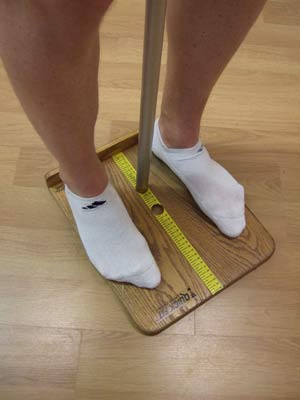 |
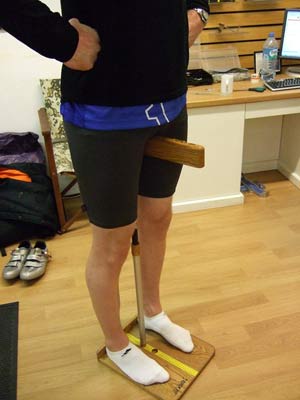 |
Every foray into cycling, be it mountain or road, I have ever undertaken has seemed to be one of constant compromise, all as a result of being on the larger side of things. [No kidding – ed.] This compromise manifests in predominantly ill-fitting, uncomfortable rides that result in tortured rather than pleasurable experiences, especially if any sort of distance is intended.
This, to a certain extent, was even experienced when climbing aboard my specially sourced 66cm Cannondale CAAD5, which, while having the proportions near-correct, still left me after three months’ acclimatisation with aching neck and shoulders, along with sharp pains in my thighs and calves.
Whilst this last proved to be an issue with the piriformis muscle irritating the sciatic nerve and was not obviously related to riding position, it was nevertheless a frustrating situation that was reducing drastically the amount of time I could comfortably spend in the saddle.
I happened to be discussing the issue with Warrick at CycleFit in London’s Covent Garden, expressing the view that I would just have to learn to deal with it in order to be a cyclist as I had in the past when, perhaps unsurprisingly, the discussion ended with a suggestion that I undergo a CycleFit session to see what was what.
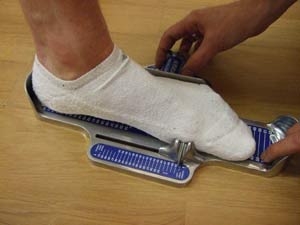 |
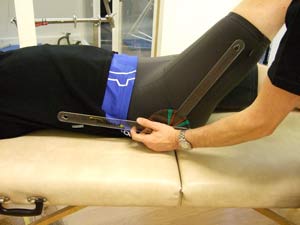 |
The session comprises a close look at all aspects of fit and usage of your cycle, beginning with a questionnaire prior to the session asking general questions relating to type of cycling and level of fitness, along with where you’re intending to take your cycling. It kicks off with an involved measuring session beginning at the feet with sizing and arch shape before moving up to measure the individual hamstring lengths and hip flexor angle.
This is followed by a somewhat disconcerting inseam measurement using what can only be described as an invasively dangerous device with high comedic value (but apparently quite amusing to watch given the expression on the editor’s face at the time). Assessment of flexibility and curvature of the back is also taken into account.
Once the measurements are completed, it’s time to sort out any problems with the feet, starting with moulding a custom foot bed, and then applying ‘lewedges’ to the cleats with the aim of ensuring a balanced foot position. While the footbed moulding is taking place the technician adjusts CycleFit’s Serotta Size Cycle to an approximation of what they believe is a good fit for your size. Then, it’s time to get on and warm up.
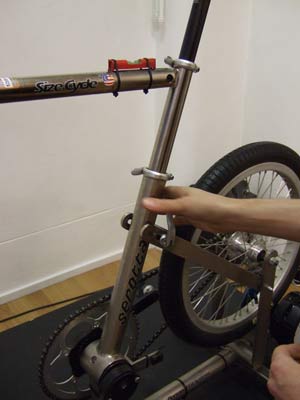 |
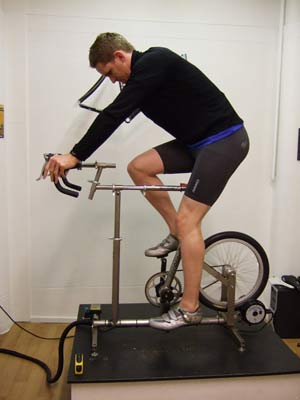 |
While warming up, you can try to get your head around the information presented in front of you; graphs showing power output from each leg and where in the pedal stroke power is generated along with the standard cadence measurement so you can ensure you’re at the appropriate 90rpm. Besides the graphical information, there’s a camera trained on you enabling real time feedback of what you actually look like in the saddle. This enables you to ensure a steady and even stroke.
Once you’re into a steady cadence the technician begins to review your riding style, looking for any obvious movement problems that might need correcting along with querying your general position and comfort on the bike while making adjustments to the fit of the cycle. This continues until you feel you are in a comfortable riding position, and the technician is happy with your riding action.
In my particular case, getting the handlebar position, both height and length took a bit of messing around while the lewedges under my cleats needed a bit of fettling to get my knees pedalling in parallel. The measurements are then documented for you to apply to your current bike, and you are done!
So, did it help? Well it’s now been about 18 months since I had the fit session, and after making the changes suggested to my bike I’ve averaged 150-250 km a week, mostly commuting, but thrown in to the mix were a few sportives including the Dragon Ride and Southern Sportive, the odd epic training ride and even my first time trial [23’56” for 10 miles – ed.]. Although I still get a bit of soreness across the shoulders and stiffness in the neck, I feel remarkably comfortable on the bike over quite reasonable distances.
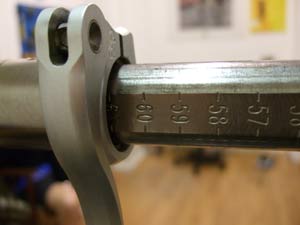 |
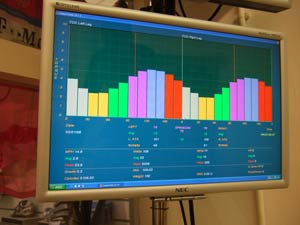 |
Would I recommend it to others? – Yup; do I think it’s of value? – Yes. There really is no sense in forking out what can be a considerable amount of cash for a bike if you’re not getting yourself to fit on it properly. It really should be a part of the new bike purchase experience. I also felt, 12 months down the track, that the fit session should be re-visited, taking into account any changes you have made in fitness and ability over that time along with potentially picking up on any bad habits you may have also developed.
In sum, it gives you the reassurance of receiving knowledgeable help in ensuring your bike is a good fit for you and the satisfaction of riding in comfort!
A Cyclefit costs £210.00 plus £50.00 for footbeds



